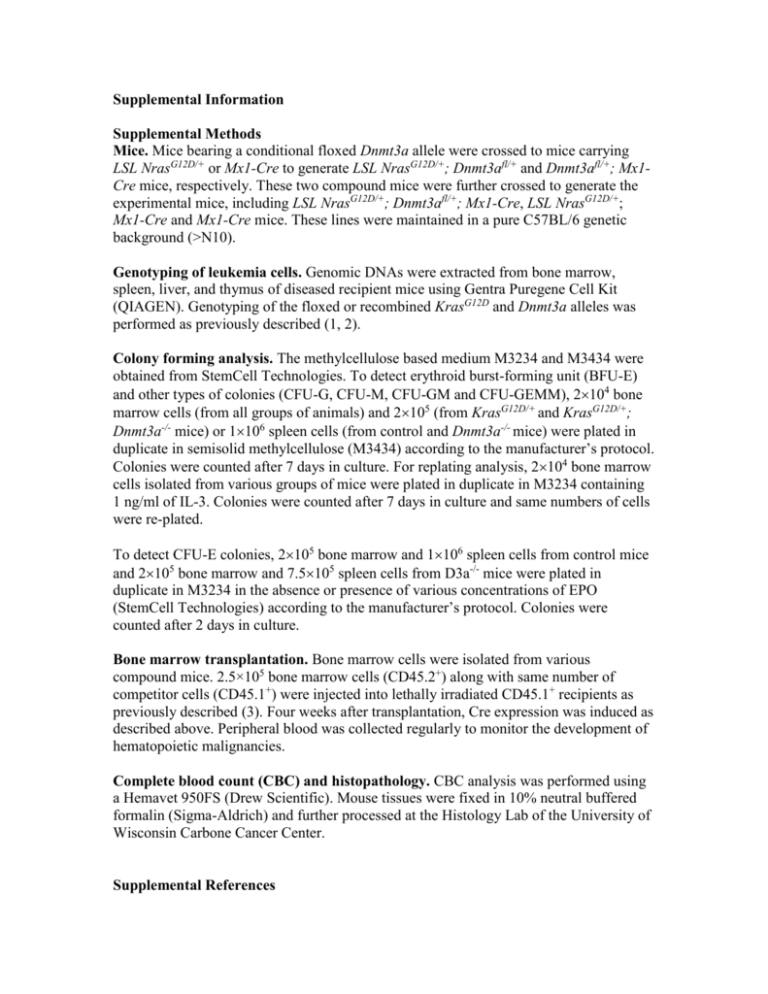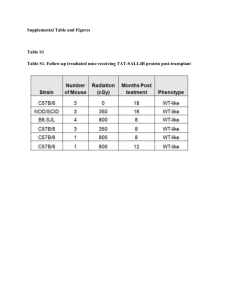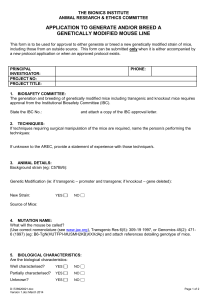Supplementary Information (doc 48K)
advertisement

Supplemental Information Supplemental Methods Mice. Mice bearing a conditional floxed Dnmt3a allele were crossed to mice carrying LSL NrasG12D/+ or Mx1-Cre to generate LSL NrasG12D/+; Dnmt3afl/+ and Dnmt3afl/+; Mx1Cre mice, respectively. These two compound mice were further crossed to generate the experimental mice, including LSL NrasG12D/+; Dnmt3afl/+; Mx1-Cre, LSL NrasG12D/+; Mx1-Cre and Mx1-Cre mice. These lines were maintained in a pure C57BL/6 genetic background (>N10). Genotyping of leukemia cells. Genomic DNAs were extracted from bone marrow, spleen, liver, and thymus of diseased recipient mice using Gentra Puregene Cell Kit (QIAGEN). Genotyping of the floxed or recombined KrasG12D and Dnmt3a alleles was performed as previously described (1, 2). Colony forming analysis. The methylcellulose based medium M3234 and M3434 were obtained from StemCell Technologies. To detect erythroid burst-forming unit (BFU-E) and other types of colonies (CFU-G, CFU-M, CFU-GM and CFU-GEMM), 2104 bone marrow cells (from all groups of animals) and 2105 (from KrasG12D/+ and KrasG12D/+; Dnmt3a-/- mice) or 1106 spleen cells (from control and Dnmt3a-/- mice) were plated in duplicate in semisolid methylcellulose (M3434) according to the manufacturer’s protocol. Colonies were counted after 7 days in culture. For replating analysis, 2104 bone marrow cells isolated from various groups of mice were plated in duplicate in M3234 containing 1 ng/ml of IL-3. Colonies were counted after 7 days in culture and same numbers of cells were re-plated. To detect CFU-E colonies, 2105 bone marrow and 1106 spleen cells from control mice and 2105 bone marrow and 7.5105 spleen cells from D3a-/- mice were plated in duplicate in M3234 in the absence or presence of various concentrations of EPO (StemCell Technologies) according to the manufacturer’s protocol. Colonies were counted after 2 days in culture. Bone marrow transplantation. Bone marrow cells were isolated from various compound mice. 2.5×105 bone marrow cells (CD45.2+) along with same number of competitor cells (CD45.1+) were injected into lethally irradiated CD45.1+ recipients as previously described (3). Four weeks after transplantation, Cre expression was induced as described above. Peripheral blood was collected regularly to monitor the development of hematopoietic malignancies. Complete blood count (CBC) and histopathology. CBC analysis was performed using a Hemavet 950FS (Drew Scientific). Mouse tissues were fixed in 10% neutral buffered formalin (Sigma-Aldrich) and further processed at the Histology Lab of the University of Wisconsin Carbone Cancer Center. Supplemental References 1. Tuveson DA, Shaw AT, Willis NA, Silver DP, Jackson EL, Chang S, et al. Endogenous oncogenic K-ras(G12D) stimulates proliferation and widespread neoplastic and developmental defects. Cancer Cell 2004 Apr; 5(4): 375-387. 2. Nguyen S, Meletis K, Fu D, Jhaveri S, Jaenisch R. Ablation of de novo DNA methyltransferase Dnmt3a in the nervous system leads to neuromuscular defects and shortened lifespan. Dev Dyn 2007 Jun; 236(6): 1663-1676. 3. Zhang J, Wang J, Liu Y, Sidik H, Young KH, Lodish HF, et al. Oncogenic Krasinduced leukemogeneis: hematopoietic stem cells as the initial target and lineagespecific progenitors as the potential targets for final leukemic transformation. Blood 2009 Feb 5; 113(6): 1304-1314. 4. Socolovsky M, Nam H, Fleming MD, Haase VH, Brugnara C, Lodish HF. Ineffective erythropoiesis in Stat5a(-/-)5b(-/-) mice due to decreased survival of early erythroblasts. Blood 2001; 98(12): 3261-3273. Supplemental Figure Legends Figure S1. Loss of Dnmt3a induces a transient anemia in vivo. Control and Dnmt3afl/fl; Mx1-Cre mice were treated with pI-pC as described in Materials and Methods. (A) Complete blood count was performed regularly after pI-pC treatment. The results are presented as means ± SD. ***P<0.001. (B) Different lineages of cells from bone marrow (BM), spleen (SP), and peripheral blood (PB) of control and Dnmt3a-/- mice were analyzed using flow cytometry two months after pI-pC treatment. No significant changes were observed. Figure S2. Loss of Dnmt3a induces moderately increased erythropoiesis in spleen two months after pI-pC treatment. Control and Dnmt3afl/fl; Mx1-Cre mice were treated with pI-pC and sacrificed two months after pI-pC treatment when Dnmt3a-/- (D3a-/-) mice developed a transient anemia. (A) Representative spleen histologic H&E sections from control and D3a-/- mice. (B, C) Erythroid differentiation was analyzed in bone marrow (BM) and spleen (SP) of control and D3a-/- mice as previously described (4). (E,F) CFUE assay was performed in the absence or presence of various concentrations of EPO. Colony numbers cultured in the presence of 3 U/ml of EPO are shown (E) and set as 100% (F). The results are presented as means ± SD. * P<0.05. Figure S3. Recipients transplanted with Dnmt3a-/- bone marrow cells die of hematopoietic malignancies after a prolonged latency. 2.5 X 105 control or Dnmt3a-/bone marrow cells along with same number of competitor cells were transplanted into individual lethally irradiated mice. (A) Kaplan-Meier survival curves were plotted against days after transplantation. (B) Quantification of thymus and spleen weights in different groups of recipients. (C) Flow cytometric analysis of lymphoid compartment in different hematopoietic tissues. The results are presented as means ± SD. * P<0.05. Figure S4. Representative spleen histologic H&E sections from moribund recipient mice transplanted with KrasG12D/+ (Kras) or KrasG12D/+; Dnmt3a-/- (Kras; D3a-/-) cells. MPN, myeloproliferative neoplasm; AML, acute myeloid leukemia. Figure S5. Genotyping analysis of leukemia cells. Bone marrow cells from moribund recipient mice with myeloid diseases were isolated. Genomic DNAs from various mice were subjected to genotyping analysis as described in Supplemental methods. Figure S6. Loss of Dnmt3a in KrasG12D/+ cells promotes development of two types of T-ALL. Lethally irradiated mice were transplanted with 2.5×105 bone marrow cells from different groups of mice along with same number of competitor cells. Four weeks after transplantation, Cre expression was induced by pI-pC injections. (A) Frequency of donorderived T cells (Thy1.2+ CD19-) in thymus from different groups of recipients. (B, C) Quantification of CD4- CD8- T cells in thymus (B) and thymus weight (C). (D) Analysis of Notch1 type I deletion in different groups of recipient mice with T-ALL. The results are presented as means ± SD. * P<0.05, ** P<0.01 and *** P<0.001.





